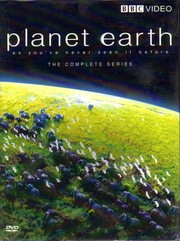
Planet Earth
By Mark Brownlow, Alastair Fothergill, Jonny Keeling
Subjects: Lion, Salmon, Cordyceps, Baboons, Gnus, Rain forest plants, Weather, Wolverine, Birds, Monkeys, Prairies, Great gray owl, Sea turtles, Bactrian camel, Shrimps, Moral and ethical aspects, Nautilus, Wolves, Chicadas, Guanaco, Taigas, Salamanders, Emperor penguin, Hypogean fishes, Ecotourism, Lobsters, Pygmy hog, Wildlife photography, Caves, Giant panda, Swifts, Ocean, Red kangaroo, Flying lemurs, Water conservation, Africa, Tunda animals, Quelea quelea, Effect of human beings on, Caving, Grizzly bear, Frigate-birds, Birds of paradise (Birds), Habitat (Ecology), Freshwater fishes, Endangered species, Asiatic wild asses, Marine fishes, Grasslands, Cave animals, Polar bear, Red panda, Blue whale, King penguin, Pitcher plants, Habitat conservation, Sea urchins, Humpback whale, Cormorants, Cranes, Muskox, Dolphins, Nature, Continental shelf, Forest animals, Climatic changes, Foxes, Snow leopard, Oryx, Crabs, Deserts, Snow goose, Sea lions, Ibex, Pudus, Vultures, Plankton, Rain forest animals, Mandarin duck, Clams, Deer, Coast redwood, Insects, Martens, Ocean sunfish, Boobies (Birds), Biospeleology, Whale shark, Red deer, Seagrasses, Giant salamanders, Trees, Wild dogs, Seasons, Conservation of natural resources, Rays (Fishes), Lynx, Rain forests, Musk deer, Gazelles, Yak, Wildlife conservation, White shark, Environmental aspects, Krill, Overpopulation, Deforestation, River dolphins, Teak, Tundras, Amphibians, Squids, Swallows, Elephants, Bottlenose dolphin, Stalactites and stalagmites, Freshwater angelfishes, Marine biodiversity, Pikas, Forest plants, Arctic fox, Whales, Buffaloes, Steppe animals, Bharal, Rocky Mountain bristlecone pine, Environmental protection, Marine biology, Prairie animals, Leopardus, Mouse lemurs, Echolocation (Physiology), Locusts, Sea horses, Mangrove forests, Piranhas, Cave plants, Environmental ethics, Animal defenses, Savannas, Corals, Saguaro, Sea snakes, Human ecology, Bats, Green turtle, Puma, Smooth otter, Seals (Animals), Crocodiles, Forest biodiversity, Lizards, Caribou, Coral reefs and islands, Brindled gnu, Migration, Jungles, Starfishes, Cave diving, Baobab, Walrus, Animal diversity, Troglodytes, Mobulidae, Sharks, Philosophy, Leopard, Steppes
Description: With a production budget of $25 million, the makers of Blue Planet: Seas of Life crafted this epic story of life on Earth. Five years in production, with over 2, 000 days in the field, using 40 cameramen filming across 200 locations, and shot entirely in high definition, Planet Earth is an unparalleled portrait of the "third rock from the sun." This stunning television experience captures rare action in impossible locations and presents intimate moments with our planet's best-loved, wildest, and most elusive creatures. Employing a revolutionary new aerial photography system, the series captures animal behavior that has never before been seen on film. The series features high-definition footage from outer space to offer a brand-new perspective on wonders such as the Himalayas and the Amazon River. From the highest mountains to the deepest rivers, this blockbuster series takes you on an unforgettable journey through the daily struggle for survival in Earth's most extreme habitats. Planet Earth goes places viewers have never seen before, to experience new sights and sounds. The set contains the original U.K. broadcast version, including 90 minutes of footage not aired on the Discovery Channel's U.S. telecasts, and features narration by natural history icon David Attenborough. The standard edition also features 110 minutes of behind-the-scenes footage -- one 10-minute segment for each episode, and Planet Earth - The Future, a three-part, two-and-a-half-hour look at the possible fate of endangered animals, habitats, and humanity. Following the environmental issues raised by Planet Earth, this feature explores why so many species are threatened and how they can be protected in the future. - Publisher.
Comments
You must log in to leave comments.